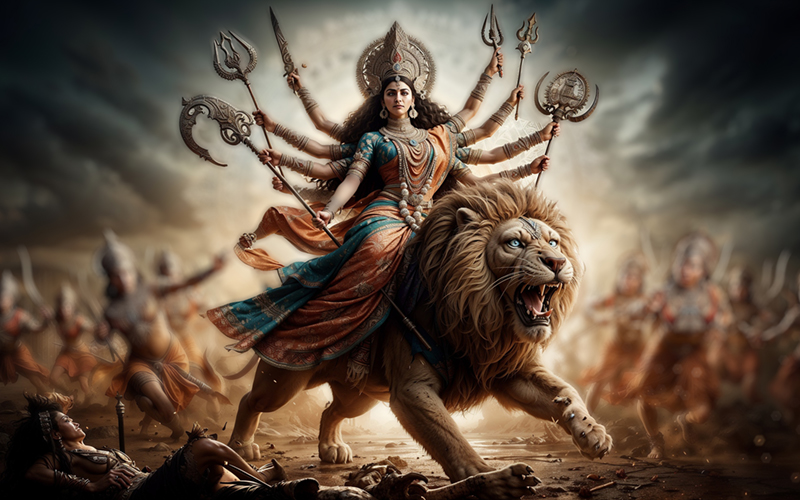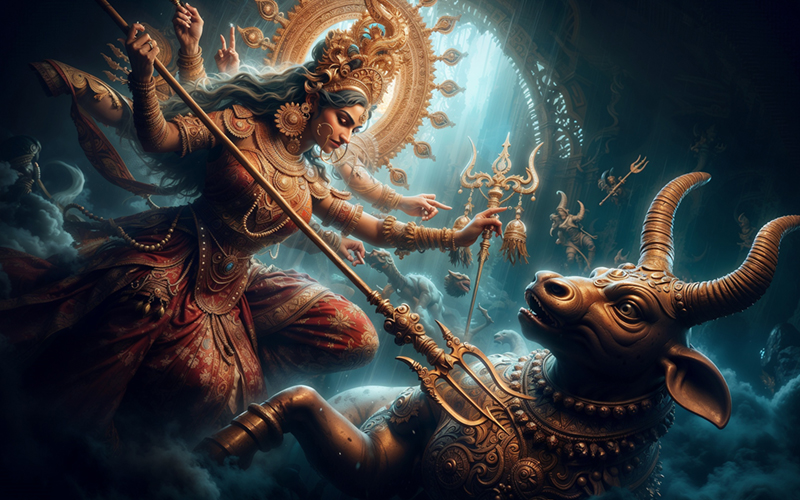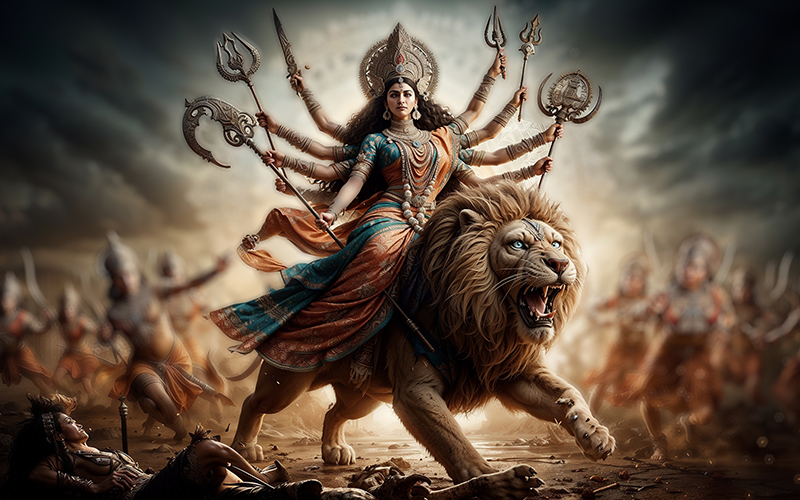Physical Address
Empirical System, 105 First Floor Pitru Krupa, Opp. R.K. Desai College, Koparli Road, Vapi (Gujarat) 396 191
Physical Address
Empirical System, 105 First Floor Pitru Krupa, Opp. R.K. Desai College, Koparli Road, Vapi (Gujarat) 396 191

Within the cosmic dance of creation and destruction, some tales serve as eternal lighthouses, guiding us away from the shores of darkness. The story of Mahishasura and the magnificent manifestation of Goddess Durga is one such beacon. It’s more than a myth; it’s a divine lesson on the nature of ego, the power of devotion, and the ultimate invincibility of Dharma.
This is the story of how the universe, thrown into chaos by an Asura’s arrogance, corrected its balance by giving birth to the Supreme Feminine Energy—the Divine Mother herself.
Our story begins in the primordial era, with the great Prajapati Daksha and the revered sage Kashyapa. Kashyapa married thirteen of Daksha’s daughters, and through these unions, the cosmic stage was set with a diverse cast of beings. From his wife Aditi came the Devas (gods), the forces of light and order. And from his wives Diti and Danu came the Daityas and Danavas (often called Asuras), powerful beings driven by ambition and a thirst for power.
Among the sons of Danu were two mighty Asura kings, Rambha and Karatbhau. It was Rambha’s journey that would sow the seed for one of the greatest conflicts the heavens had ever seen.
Driven by a desire for unparalleled power, Rambha performed severe austerities. His penance was so great that he was blessed with immense strength. One day, he encountered a beautiful water buffalo—a Mahishi—who was, in truth, a celestial princess under a curse. Captivated, Rambha married her, and from this unique union, a being of extraordinary power was born: Mahishasura.
Mahishasura was a paradox of creation. He possessed the raw, untamable ferocity of a buffalo and the cunning, strategic mind of an Asura king. His most formidable ability was to shapeshift between his human and buffalo forms at will, making him a truly unpredictable and terrifying foe. His name itself, Mahisha-Asura, meant the “Buffalo Demon,” a title he would soon make the heavens tremble to hear.
As Mahishasura’s power grew, so did his ego. He believed he was destined to rule all three realms—heaven, earth, and the netherworld. To achieve this, he knew he needed a divine advantage. He began an intense penance to please Lord Brahma, the Creator.
For ages, he stood unwavering, his focus so absolute that cosmic energy radiated from him. Pleased, Lord Brahma appeared and offered him a boon. With calculated cunning, Mahishasura asked for immortality. Brahma explained that absolute immortality goes against the laws of creation—all that is born must one day perish.
So, Mahishasura devised what he believed was the perfect, loophole-free request:
“Grant me this, O Creator: that my death shall not be caused by any god, demon, or man.”
In his hubris, he saw women as weak and beneath consideration, never imagining one could pose a threat. Brahma, bound by the Asura’s penance, granted the boon. Mahishasura was ecstatic. In his mind, he was now invincible.
Empowered by his boon, Mahishasura unleashed a wave of terror. He led his Asura armies against the Devas, and not even Indra, the King of Gods, could stand against him. The divine weapons of the gods were useless. Indra’s Vajra (thunderbolt) glanced off him harmlessly.
Defeated and humiliated, the Devas were cast out of their celestial abode. Mahishasura seized Indra’s throne and declared himself the supreme ruler of the cosmos. Dharma (righteousness) was replaced by Adharma (unrighteousness). The cosmic balance was shattered, and prayers went unanswered as the forces of chaos reigned supreme.

Desperate, the Devas sought refuge with the Holy Trinity—Brahma, Vishnu, and Shiva. As they recounted the tale of Mahishasura’s tyranny, a divine plan began to form. Mahishasura’s boon had a fatal flaw, a loophole born of his own arrogance. He could not be killed by a man or a god, but he had forgotten the ultimate power in the universe: Shakti, the divine feminine energy.
From the combined divine energies of the Trinity and all the other gods, a magnificent being of light began to manifest. This was no ordinary goddess; this was the collective power of the entire pantheon, given a divine feminine form.
She was Goddess Durga, the inaccessible one. Her form was blindingly beautiful yet terrifyingly powerful. She had ten arms, each holding a lethal weapon gifted by the gods: Shiva’s trident, Vishnu’s discus, Vayu’s bow and arrows, and Indra’s thunderbolt. Her mount was a ferocious lion, a symbol of courage and might. She was the embodiment of divine fury and grace, created for a single purpose: to annihilate Mahishasura and restore Dharma.
When news of a beautiful woman challenging his rule reached Mahishasura, he laughed. He sent his mightiest generals, but Durga and her lion decimated his armies with ease. Enraged, Mahishasura entered the battlefield himself.
The ensuing battle shook the foundations of the universe. Mahishasura shapeshifted constantly—from a mighty buffalo to a fierce lion, a giant elephant, and a human warrior. But for every form he took, Durga had a counter. Her patience was infinite, her focus absolute.
Finally, Mahishasura returned to his most powerful form—the colossal buffalo—and charged at her. In a climactic moment, Durga’s lion pounced on him, immobilizing him. As he struggled, Durga pinned him to the ground with her trident. In a last-ditch effort, the demon began to emerge from the buffalo’s neck in his human form.
Seeing this, Durga, now known as Mahishasuramardini (“The Slayer of Mahishasura”), acted swiftly. With a single stroke of her divine sword, she decapitated him, ending his reign of terror forever.

The defeat of Mahishasura is celebrated every year during Navratri and Durga Puja, culminating in Vijayadashami. But this story’s true vibration lies in its symbolism.
The story of Mahishasuramardini reminds us that no matter how powerful darkness may seem, it always contains the seed of its own destruction—usually in the form of arrogance. And when righteousness is threatened, the Divine will manifest in whatever form is necessary to restore balance.
Which aspect of Goddess Durga’s power inspires you the most? Share your reflections in the comments below!